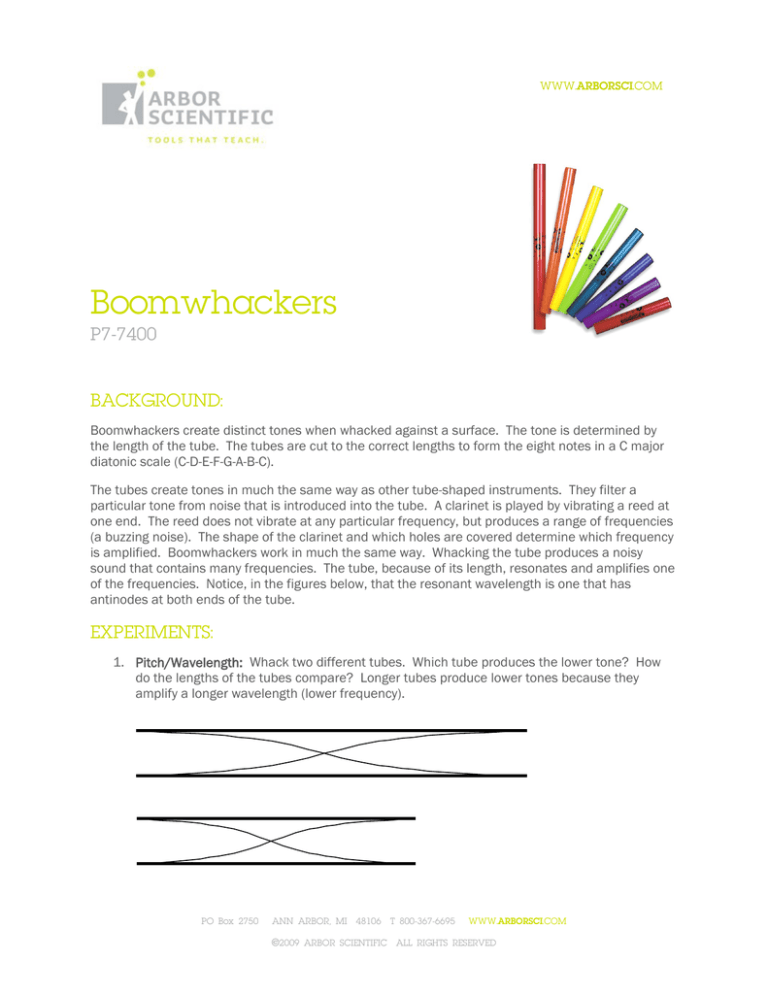
WWW.ARBORSCI.COM
Boomwhackers
P7-7400
BACKGROUND:
Boomwhackers create distinct tones when whacked against a surface. The tone is determined by
the length of the tube. The tubes are cut to the correct lengths to form the eight notes in a C major
diatonic scale (C-D-E-F-G-A-B-C).
The tubes create tones in much the same way as other tube-shaped instruments. They filter a
particular tone from noise that is introduced into the tube. A clarinet is played by vibrating a reed at
one end. The reed does not vibrate at any particular frequency, but produces a range of frequencies
(a buzzing noise). The shape of the clarinet and which holes are covered determine which frequency
is amplified. Boomwhackers work in much the same way. Whacking the tube produces a noisy
sound that contains many frequencies. The tube, because of its length, resonates and amplifies one
of the frequencies. Notice, in the figures below, that the resonant wavelength is one that has
antinodes at both ends of the tube.
EXPERIMENTS:
1. Pitch/Wavelength: Whack two different tubes. Which tube produces the lower tone? How
do the lengths of the tubes compare? Longer tubes produce lower tones because they
amplify a longer wavelength (lower frequency).
PO Box 2750
ANN ARBOR, MI 48106 T 800-367-6695
WWW.ARBORSCI.COM
©2009 ARBOR SCIENTIFIC ALL RIGHTS RESERVED
2. Resonance: Hum loudly over the end of a tube near and at its natural frequency. The tube
will vibrate when you reach its natural frequency, in addition to amplifying the sound.
3. Resonance 2: Strike a 256 Hz tuning fork and hold it just inside the end of the longest C
tube. The tube will resonate and amplify the 256-Hz tone. Strike the tuning fork again and
hold just inside the SHORTEST C tube. The short tube also resonates, because the tuning
fork’s vibration includes another frequency, 512 Hz. This overtone is much quieter than the
fundamental tone, so it is usually not noticed.
4. Open/Closed Pipe Resonance: Whack one tube and notice the tone it produces. Cap one
end with one of the black caps and whack the tube again. How does the new tone differ
from that produced by the open tube? The capped (closed) pipe produces a tone that is
exactly one octave lower than the uncapped (open) pipe. The cap forces a node to be at the
end of the tube, and the lowest resonant wavelength is twice as long as the wavelength of
the uncapped tube. An octave is produced by doubling the frequency (or halving the
wavelength) of a sound.
5. Noise Filtering: Take the Boomwhackers to a noisy environment, such as a crowded hallway
or cafeteria. Put a tube to your ear and listen to the sounds. The tube filters and amplifies
the same tone that it produces when it is whacked. If you hold the tube tightly against your
head, it becomes a closed tube and will amplify the note an octave lower.
6. End Correction: Ideal open pipes amplify a sound whose wavelength matches the length of
the pipe. The frequencies of each note are listed below. Calculate the wavelength of each
note (wavelength = speed of sound in air / frequency) and compare them to the tube
lengths. (For open pipes, the length of the tube is HALF of the wavelength of the
fundamental tone. See the diagrams above.) The tubes are a bit shorter than the calculated
wavelengths. This is because the vibrating air in the tube does not disperse immediately at
the end of the tube. This causes the tube to effectively be slightly longer when it is played.
C 256 Hz
D 288 Hz
B 480 Hz
E 320 Hz
F 341.3 Hz
C 512 Hz
G 384 Hz
A 426.7 Hz
Thanks to Bob Williamson, Walt Krell, and Clarence Bennett for their experiment ideas.
PO Box 2750
ANN ARBOR, MI 48106 T 800-367-6695
WWW.ARBORSCI.COM
©2009 ARBOR SCIENTIFIC ALL RIGHTS RESERVED




